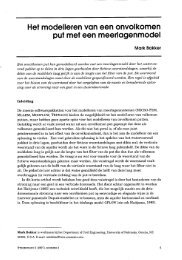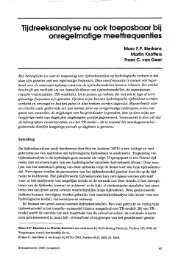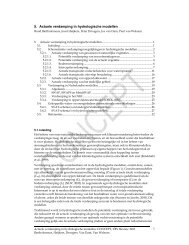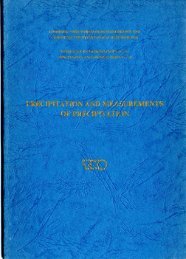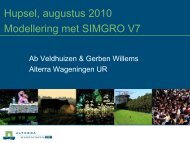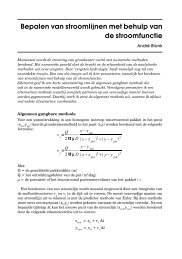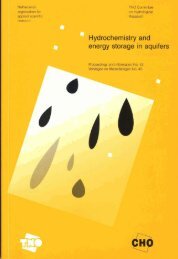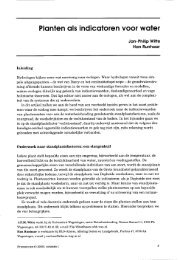Hydro-ecological relations in the Delta Waters
Hydro-ecological relations in the Delta Waters
Hydro-ecological relations in the Delta Waters
You also want an ePaper? Increase the reach of your titles
YUMPU automatically turns print PDFs into web optimized ePapers that Google loves.
estimated primary production of 500 g C mdZy-l <strong>in</strong> shallow are-. The<br />
contribution to <strong>the</strong> annual carbon budget of <strong>the</strong> Veerse Meer is roughly<br />
-E -1<br />
120 g C m y , which is 27X of <strong>the</strong> lagow' budget. The higb nitrogen<br />
load not only leads to a relatively high production of phytoplanktou,<br />
but also to <strong>in</strong>tensive and undesirable mass growth of =<strong>in</strong><br />
areas.<br />
shallow<br />
Figure 7 reveals <strong>the</strong> <strong>in</strong>areae and decrease <strong>in</strong> biomass, eapressed as<br />
perrentage wvezage, <strong>in</strong> a permaaent saaple plot In <strong>the</strong> Grevel<strong>in</strong>geu and<br />
<strong>in</strong> <strong>the</strong> Vwse Fleet!. In <strong>the</strong> Grevel<strong>in</strong>gemeer <strong>the</strong> annual cycle of cbaagerr<br />
<strong>in</strong> biomass of seagrass is not disturbed by macro-algae. which have only<br />
a low presence. In <strong>the</strong> Veezse Meer <strong>the</strong> seagraes plot becomes cmpletely<br />
dam<strong>in</strong>dted by quickly grow<strong>in</strong>g-, suppress<strong>in</strong>g <strong>the</strong> growth of zostera.<br />
Table 3 shows that <strong>the</strong> eutrophicated Veerse Meer has <strong>the</strong> highest tmtal<br />
-2 -1<br />
primary production (roughly 4-50 g C m y ) and that <strong>the</strong> nutrient<br />
limited Oosterschelde estuary has <strong>the</strong> lowest values (rdu@ly<br />
-P -1<br />
240gCrn y 1.<br />
For Ereshwater ecosystems a tentative model has beau developed,<br />
descrihlng <strong>the</strong> relation berween <strong>the</strong> relative domtuanca of primary<br />
producers wmected to <strong>the</strong> availability of nutrients. and <strong>the</strong><br />
successive phase$ <strong>in</strong> <strong>the</strong> process of %acreas<strong>in</strong>% eutrophicatton<br />
(Phillips. et al. 1978; Van Vierssen, et al. 1985; De Nfe. 1987: Fig.<br />
8, upper panel). The model for esruar<strong>in</strong>e and lagoonal situations Rig.<br />
8, loaez panel) is adapted, based on data from <strong>the</strong> Qrevel<strong>in</strong>pn and<br />
Veerse &er. The model is odly applicable to stagnant brackish lagoons<br />
and extremely sheltered parts of tidal estuaries. In "healthy" sal<strong>in</strong>e<br />
waters, waterplants - such as seagrasses - dom<strong>in</strong>ate. Nitrogen load and<br />
concentrations are lm and <strong>the</strong> relative importance of phytoplanktm <strong>in</strong><br />
<strong>the</strong> shallow seagrassbeds is iusigniEicant; <strong>the</strong> Grevelisgeumeer is an<br />
example of phase I. Zn brack3sh waters where eutropbiearim <strong>in</strong>creases,<br />
revealed by higher nitrogen loads and concentrations and lower,<br />
<strong>in</strong>stable sal<strong>in</strong>ities, waterpLants am outcompeted by macto-algae.<br />
Epiphyte gowth gn seagrass-<br />
<strong>in</strong>crea~es considerably toge<strong>the</strong>r with <strong>the</strong><br />
relative dsmtnanee of pbytoplankfou. The resilience of <strong>the</strong> aquatic<br />
cmumnitied decreases, which makes <strong>the</strong> system less constant <strong>in</strong> time end





